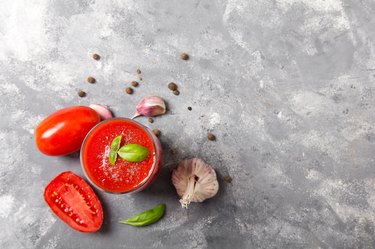
Foods and juices with strong colors can change your bowel movements to red. This particularly applies to children and weaning babies. Juiced tomatoes and vegetable juices that include ingredients such as beetroot are among foods that can cause red stool.
If you're not expecting to see such a change, it can make for quite a shock when you look back in the toilet bowl. However, red foods can cause your stools to appear red, as explained by UMassMemorial Health Care.
Video of the Day
Video of the Day
Tip
While it can be shocking to see red after you've used the toilet, it could be a harmless side effect of eating red foods such as tomatoes.
Red Stool, But Not Blood
Tomatoes and some vegetables contain strong pigments in their flesh. In tomatoes, the pigment is the carotene known as lycopene, whereas vegetables such as beets contain anthocyanin. In both cases, the pigment stays mostly intact during the digestion process. This colors the mass of broken-down food and waste that makes up a stool, so your bowel movement looks red.
You might even notice tomato in stool or small red pieces in your stool. The redness of your stools may be a small price to pay for the rich vitamin and fiber content of most freshly prepared vegetable juices.
Read more: Causes of Fresh Blood in Stool
The Younger Population
A baby's digestive system is immature, so his foods can't be broken down well. That's why mothers slowly wean babies on to solid foods. During weaning, juiced or mashed vegetables are commonly used.
According to Seattle Children's Hospital, 90 percent of red stools in children are not caused by blood. Red dye in beverages, candy and cereals are often the culprit. However, foods such as beets, cranberries, red peppers, rhubarb and tomatoes are also to blame.
When to See a Doctor
A change in bowel movement color soon after drinking tomato or vegetable juice isn't too much of a concern. If you notice that your bowel movements stay red for many days, experience tarry stool or have pain when on the toilet, however, speak to a doctor.
Similarly, if stools become very foul smelling or become very watery, you may have a bowel infection or more serious complication. If these symptoms stay around for a week or more, ask your doctor for advice.
Consider the Fiber Content
Fiber is an important carbohydrate that impacts the digestive system. Fiber promotes intestinal regularity, according to the U.S. Food and Drug Administration.
Tomato and vegetable juices contain a lot of dietary fiber, particularly if the juice is pulpy and thick. Fiber helps bowel movements by bulking stools into moist, firm shapes that pass easily.
In some people, however, such as those with irritable bowel syndrome, very high fiber can cause digestive irritation. This might lead to foods moving through the bowel faster. That means more part-digested food, such as tomato skin and beet fragments. This could make your stool look even redder.
Is this an emergency? If you are experiencing serious medical symptoms, please see the National Library of Medicine’s list of signs you need emergency medical attention or call 911.